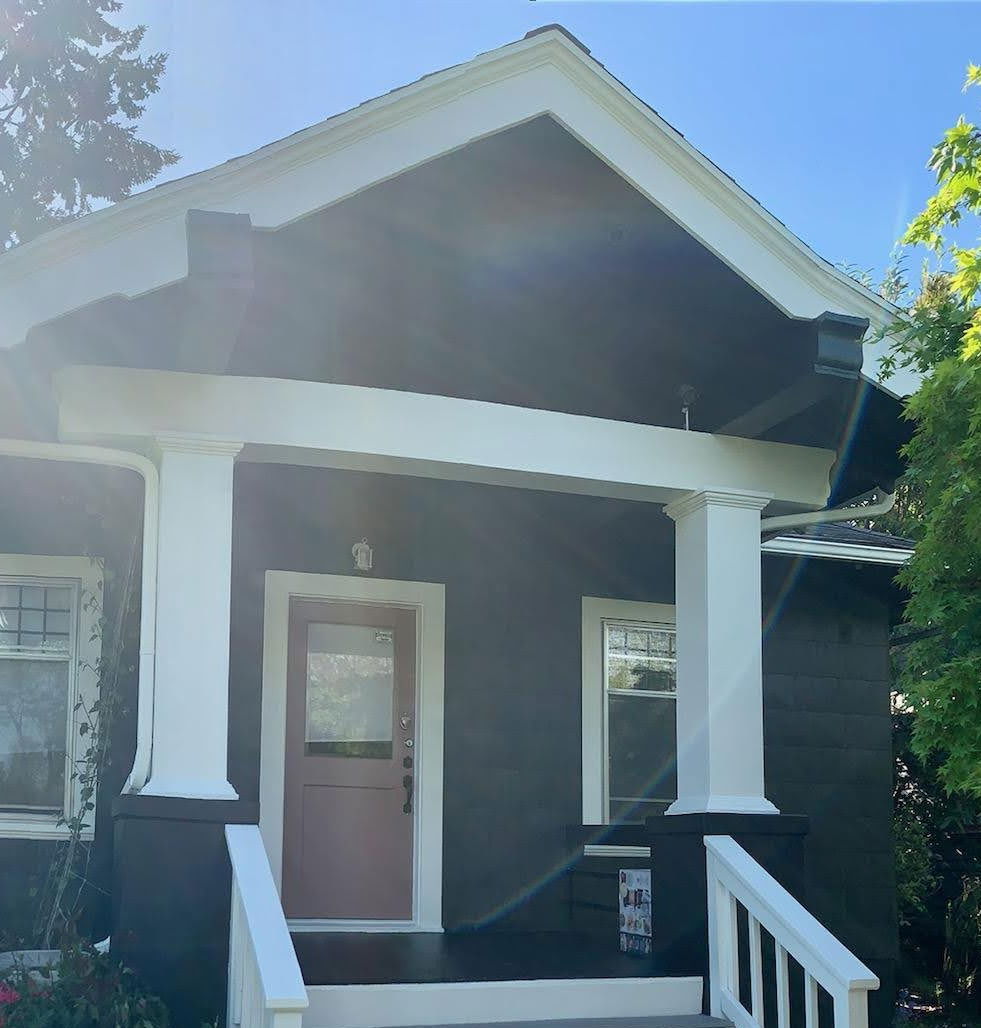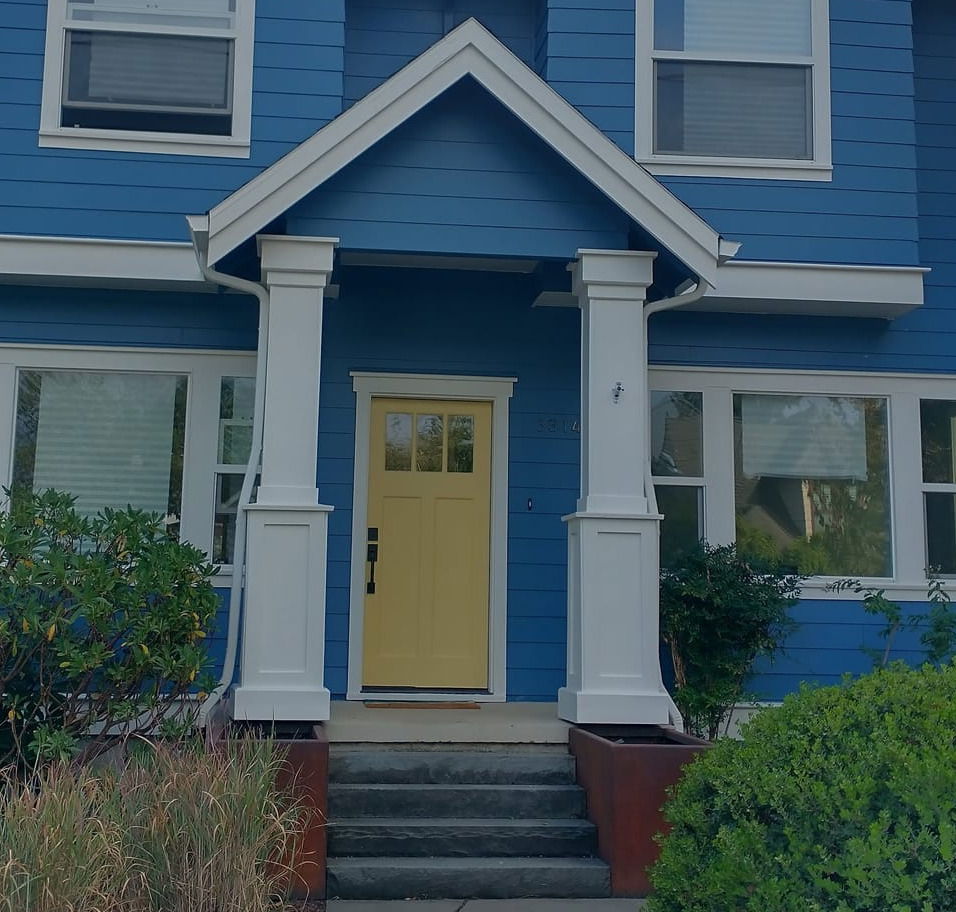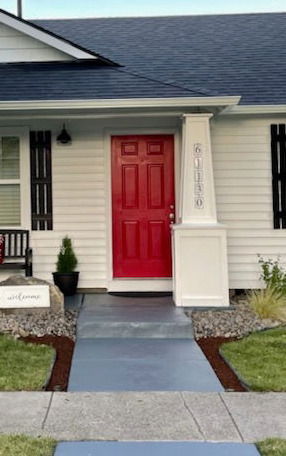How to Pick a Front Door Color: Expert Tips

Key Highlights of the Article
- Understanding Color Psychology: How different colors can set the tone and affect the curb appeal of your home.
- Practical Tips for Choosing Colors: Including testing colors, considering finishes, and coordinating with exterior features.
- Avoiding Common Mistakes: Important pitfalls to avoid, such as ignoring the home’s style or underestimating the impact of lighting.
- Balancing Trends with Timelessness: Tips on choosing a front door color that feels current yet will stand the test of time.
Let’s Talk Front Door Colors: Choosing the Perfect Hue for Your Home
Opening Statement
A front door isn't just a functional entryway; it's a statement piece that sets the tone for your home's exterior. The right front door color can significantly enhance curb appeal, making your home stand out in the best possible way. But with so many options, choosing the perfect front door color can feel like a daunting task. Don’t worry—I’m here to simplify the process and make it fun!
Understanding the Impact of Front Door Color
The Role of Color in Curb Appeal
First Impressions Matter:
Think about it—your front door is often the first thing guests and passersby notice. It’s like the opening act of a grand performance; you want it to set the stage just right. Whether you’re looking to sell your home or simply want to refresh its look, the color of your front door is crucial in creating a positive first impression. A striking front door can transform a plain exterior into a head-turner, drawing eyes and inviting curiosity.
Setting the Tone:
The color of your front door isn’t just about aesthetics; it’s a reflection of who you are. Are you bold and adventurous? A red or yellow door might be calling your name. Prefer a calming sanctuary? A cool blue or green may be more your speed. Your front door’s color should harmonize with the overall style of your house while also expressing your unique personality. It’s your canvas—don’t be afraid to get creative!
Color Psychology: What Different Colors Convey

Warm Colors: Red, Yellow, Orange
Warm colors like red, yellow, and orange are perfect for creating an inviting, energetic entrance. Red is a classic choice that screams confidence and strength; it’s a color that doesn’t shy away from attention. If you’re someone who loves to make a statement, a red front door could be just what you need. Meanwhile, yellow doors are all about cheerfulness and optimism. Picture a bright yellow door on a cozy cottage—it's like a burst of sunshine greeting you every time you come home. Lastly, orange is a color of enthusiasm and warmth. It’s unconventional yet welcoming, ideal for homeowners who want their home to feel vibrant and full of life.
Cool Colors: Blue, Green, Purple
Cool colors such as blue, green, and purple offer a different vibe altogether.
Blue is known for its calming effect and can evoke feelings of peace and serenity. A deep navy or light sky blue door can add a touch of elegance and sophistication to your entryway.
Green represents harmony and balance. A green door, whether in a muted sage or a bold emerald, connects beautifully with nature and is perfect for homes with lush landscaping.
Purple is less common but can create a sense of luxury and creativity. A lavender or plum front door adds a touch of mystery and uniqueness, making your home stand out.
Neutral Colors: Black, Gray, White
For those who appreciate a classic look, neutral colors like black, gray, and white are timeless choices. A black front door is both bold and sophisticated, offering a strong contrast to lighter exteriors. It’s the little black dress of the home design world—always in style.
Gray is versatile and modern; it works well with both traditional and contemporary styles, providing a balanced, understated elegance.
White offers a crisp, clean appearance that symbolizes freshness and simplicity. It’s perfect for creating a bright, welcoming entrance, especially for homes with darker exteriors.
Things to Know
- Lighting Matters: Always consider how natural and artificial lighting will affect the appearance of your front door color at different times of the day.
- Consider the Whole Exterior: The front door should complement other elements such as the roof, trim, and landscaping.
- Test Before You Paint: Apply test swatches to observe how different colors behave under varying weather conditions and times of day.
- Maintenance Is Key: Choose a paint that not only looks good but also stands up to your local climate and is easy to maintain.
- Consult Professionals: When in doubt, consulting with design experts or professional painters can provide additional insights and help you avoid costly mistakes.
Factors to Consider When Choosing a Front Door Color
Choosing the perfect front door color isn't just about picking your favorite hue; it's about balancing aesthetics, functionality, and personal expression. Here are some key factors to consider when selecting a front door color that truly enhances your home's curb appeal.
The Architectural Style of Your Home
Matching the Style
One of the first things to consider when selecting a front door color is the architectural style of your home. Your front door color should complement the style, rather than clash with it. For example, if you own a colonial-style home, classic colors like deep reds, navy blues, or rich greens tend to work best. These colors enhance the traditional, symmetrical design that characterizes colonial architecture. On the other hand, a modern-style home with sleek lines and minimalist design can handle bolder, more unconventional colors like bright yellow or matte black, which add an element of surprise and contemporary flair.
For a cottage-style home, which often emphasizes coziness and charm, softer pastel shades like mint green, light blue, or even a warm lavender can create a welcoming feel. The key is to find a color that complements the inherent qualities of your home's architecture, enhancing its features rather than overshadowing them.
Contrasting vs. Complementary Colors
Another consideration is whether you want your front door color to contrast with or complement your home's existing color palette. A contrasting color can create a dramatic, eye-catching look. For example, a bright red door on a white house can make a bold statement and serve as a focal point that draws the eye. This approach works particularly well in minimalist or modern home designs where bold color can provide a striking accent.
On the other hand, a complementary color offers a more cohesive and harmonious look. For instance, a deep green door on a house painted in neutral earth tones like beige or taupe can create a serene and unified appearance. This is especially effective for more traditional homes, where a softer, more understated approach is often preferred.
The Surrounding Environment
Landscape and Climate Considerations
The natural environment surrounding your home plays a crucial role in choosing a front door color. Think about how the color of your front door will look against your landscaping, greenery, and flowers. For example, if your home is nestled among tall trees with lots of greenery, a warm, earthy color like terracotta or forest green might help your door blend seamlessly into the environment, creating a natural, organic look.
Climate also matters. In sunnier, warmer climates, cooler colors like light blue or seafoam green can create a refreshing contrast against the backdrop of a bright sky. In contrast, in colder regions, warmer hues such as burnt orange, burgundy, or rich brown can add a welcoming warmth to the exterior of your home.
Neighborhood Trends
While you want your front door to reflect your personal style, it's also wise to consider the broader aesthetic of your neighborhood. Take a stroll around your block and observe the color choices of your neighbors. Are they mostly neutral, or do you notice a trend towards bold, bright doors? The goal is to stand out without clashing. You can select a color that is unique but still aligns with the overall neighborhood vibe. For example, if you live in a historic district, a vivid purple door might seem out of place, whereas a classic deep blue or emerald green would still offer distinction without breaking the aesthetic continuity.

Practical Tips for Choosing the Perfect Front Door Color
Selecting the right front door color is more than just picking a shade you love; it's about ensuring that color works for your home’s style, environment, and your personal taste. Here are some practical tips to help you choose the perfect front door color with confidence.
Testing Colors Before Committing
Sampling and Testing
One of the best pieces of advice I can give is never commit to a color without testing it first. Even if you think you've found the perfect shade, it can look entirely different once it’s on the door and subjected to changing light throughout the day. I always recommend painting a few test swatches directly onto the door. Look at them in the morning, afternoon, and evening to see how the color transforms under various lighting conditions. You'll often be surprised at how a color that seems perfect in-store might look completely different in natural sunlight or under your porch light.
If you're testing multiple colors, make sure to place them side by side to compare how they interact with one another. This helps to gauge which hue best complements the rest of your home's exterior and aligns with the look you want to achieve.
Considering Finish Options
Don’t forget that the finish of your paint also plays a significant role in how the color is perceived. A matte finish can offer a subtle, elegant appearance, perfect for a sophisticated, understated look. However, if you’re leaning toward a more modern or bold aesthetic, a semi-gloss or high-gloss finish might be the way to go. These finishes not only provide a vibrant shine that makes the color pop but also offer better durability and easier cleaning—important considerations for an exterior door that sees a lot of use and exposure to the elements.
Coordinating with Exterior Features
Harmony with Trim and Shutters
Your front door should feel like a seamless part of your home's overall design. To achieve this, pay attention to the colors of your trim, shutters, and other exterior features. If your home has white or neutral trim, nearly any color can work for the door. However, if your trim or shutters are in a more specific hue—like forest green or burgundy—you’ll want a door color that either complements or contrasts tastefully with these existing elements.
For example, if your shutters are navy blue, a crisp white or soft gray door can provide a lovely contrast, or you could go with a more vibrant color like yellow or coral to create a bold statement. Remember, harmony doesn’t mean everything has to match exactly; it’s about creating a balanced, cohesive look that ties all the exterior elements together.
Complementing the Roof and Siding
When choosing your front door color, it’s also crucial to consider how it will work with the roof and siding. Your roof is a major visual component of your home, and its color can either support or clash with your door choice. For example, if you have a warm-toned roof like red or brown shingles, consider warm colors for your door, such as deep reds, oranges, or a classic wooden finish. For cooler-toned roofs like slate gray or blue, cooler door colors such as navy, green, or even a sleek black might work best.
Your siding, whether it’s brick, stone, wood, or vinyl, also needs to harmonize with your door color. For instance, a bold red door might look stunning against light gray siding but might clash with orange-toned brick. Make sure your door color complements, rather than competes with, these substantial exterior features.
Seasonal and Long-Term Considerations
Weather Resistance and Durability
When choosing a front door color, it’s essential to think about how well the paint will withstand the elements. Doors face direct exposure to sunlight, rain, wind, and sometimes even snow or salt air, depending on where you live. Make sure to choose a high-quality exterior paint specifically designed for outdoor use. Look for paints that are UV-resistant to prevent fading and weather-resistant to handle whatever Mother Nature throws at them. The right paint will retain its vibrancy and protect your door material from weather-related damage for years.
Considering Future Trends
We all love to be on-trend, but remember that what's hot today might not be in a few years. When selecting a front door color, aim for a balance between trendy and timeless. Bold colors like turquoise or bright orange might be in vogue now, but think about whether you’ll love that look in five or ten years. Opting for a classic color with a modern twist—like a deep navy or rich emerald green—can keep your home looking fresh and appealing over time.
If you’re set on trying a trendy color, consider how easy it will be to repaint when the trend passes or your taste changes. Remember, your front door makes a statement about you and your home, so choose a color that reflects your personality and makes you feel happy every time you walk through it.
In Our Experience:
"We've seen firsthand how the right front door color transforms homes. A carefully chosen hue not only enhances the home's exterior but also resonates with the homeowner's personal style, making the house truly stand out. Our successful projects across Portland showcase the power of a perfectly painted front door to refresh and revitalize a home's appearance."
H2: Common Mistakes to Avoid When Choosing a Front Door Color
H3: Ignoring the Home’s Style
- Mismatch with Architecture: Warn against choosing colors that clash with the home’s architectural style and historical context.
- Overlooking the Home’s Age: Explain how the age of a home can influence appropriate color choices, especially for historic homes.
H3: Underestimating the Impact of Lighting
- Natural Light vs. Artificial Light: Highlight the importance of considering how different lighting conditions can alter the appearance of the door color.
- Failing to Test in Various Conditions: Emphasize the need to test colors at different times of day and in different weather conditions.
H2: Conclusion: Final Thoughts on Choosing the Perfect Front Door Color
- Recap: Summarize the key points—understanding the impact of color, considering architectural style and surroundings, testing colors, and avoiding common mistakes.
- Encouragement: Motivate readers to take their time and enjoy the process of choosing a front door color that enhances their home’s curb appeal and reflects their personality.
Do You Have Questions? Give Us A Call With Any & All! 503-389-5758
-
People Also Ask:
What does your front door color say about you?
The color of your front door can say a lot about your personality and style. Warm colors like red, yellow, and orange can convey warmth and welcome, suggesting an inviting and vibrant home environment. Cool colors like blue and green often symbolize tranquility and calm, reflecting a serene and sophisticated atmosphere. Neutrals like black or gray signify elegance and a timeless appeal.
How do I choose the right color for my front door?
Choosing the right front door color involves considering several factors, including the architectural style of your home, the surrounding environment, and your personal taste. It's essential to match or contrast the door color with your home's overall color scheme and consider how the color will look under different lighting conditions. Testing paint swatches on your door can also help ensure you make the best choice.
Can changing my front door color increase home value?
Yes, changing your front door color can potentially increase your home's curb appeal and, consequently, its overall value. A well-chosen door color that enhances the home’s exterior and fits well with the neighborhood can make a great first impression on potential buyers, potentially making the home more attractive and marketable.
-
SUBSCRIBE TO OUR BLOG: Stay informed with the latest in Painting and DIY projects by subscribing to Lightmen Painting. Get insights, tips, and more delivered straight to your inbox. We would also love to know what you would like to read about, leave thoughts on where we should go next. Interests, Topics, Ideas, all are welcome.
If your in the Portland, Or. area and need advice or a free no obligation estimate call us at 503-389-5758 or email scheduling@lightmenpainting.com
Shout Out:
Celebrating The Raleigh Paint Contractor: Your Guide to Quality Painting Services
From the team at Lightmen Painting, we extend our highest praise to The Raleigh Paint Contractor for their dedication to providing valuable insights on interior painting costs and services. Just as we are committed to transparency and excellence in our painting work, The Raleigh Paint Contractor helps homeowners understand the true costs and benefits of quality interior painting. Their commitment to customer education and satisfaction aligns perfectly with our mission to deliver top-tier painting solutions.
Thanks for stopping by Lightmen Daily! Stay tuned for more practical tips and expert advice on making your painting projects flawless, from wall to floor!
Definitions
- Curb Appeal: The attractiveness of a property's exterior when viewed from the street, crucial in real estate valuations and buyer first impressions.
- Color Psychology: The study of hues as a determinant of human behavior, important in selecting a door color that evokes desired emotions.
- Architectural Style: The category of architecture that a home falls into, such as modern, colonial, or craftsman, which influences appropriate aesthetic decisions.
- Personal Style: An individual’s unique taste expressed through design choices, reflecting personal preferences and lifestyle.
- Climate Considerations: The impact of local weather conditions on the suitability and durability of exterior paint colors.
- UV Protection: The ability of a paint to resist fading and degradation from ultraviolet light exposure.
- Paint Finish: The sheen or glossiness of paint, affecting both the appearance and durability of the paint job.
- Maintenance Requirements: The necessary upkeep associated with a home feature, influencing choices that might require less frequent touch-ups.
- Trendy vs. Timeless: A consideration in color selection between opting for a modern, trendy look or a classic, enduring style.
- Color Harmony: The pleasing combination of colors based on their relationships on the color wheel, important in creating a balanced and appealing look.
Lightmen Painting Serving: Portland, Tigard, Lake Oswego, Tualatin, West Linn, Milwaukie, Sherwood, Happy Valley, Oregon City, Beaverton, Hillsboro, Gresham -Trade Partners-

